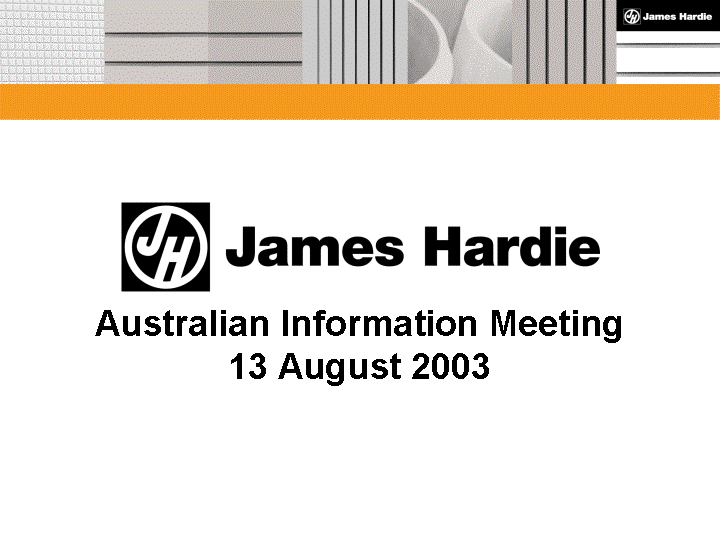
Exhibit 99.1

| Australian Information Meeting 13 August 2003 |
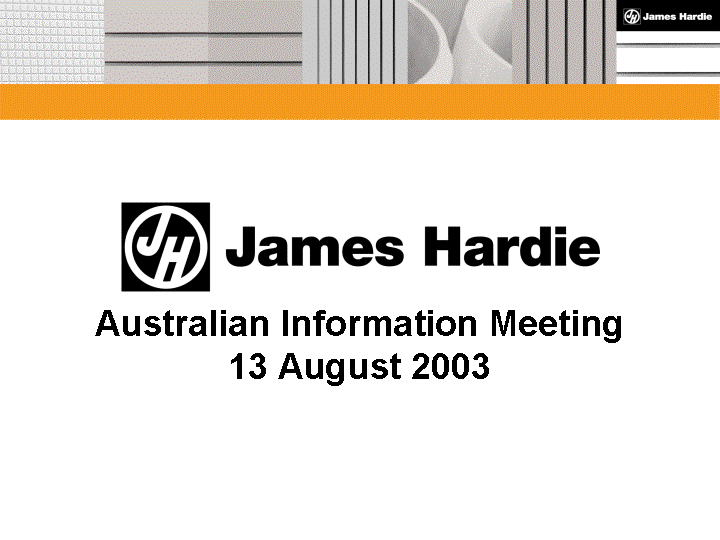
| Australian Information Meeting 13 August 2003 |
Last year on this occasion, I described the transformation that had occurred at James Hardie over the preceding 10 years. That was designed as a landmark speech to summarise our evolution into a focussed fibre cement company with strong growth prospects.
Today I am pleased to say that over the last 12 months, progress has exceeded the expectations then set out.
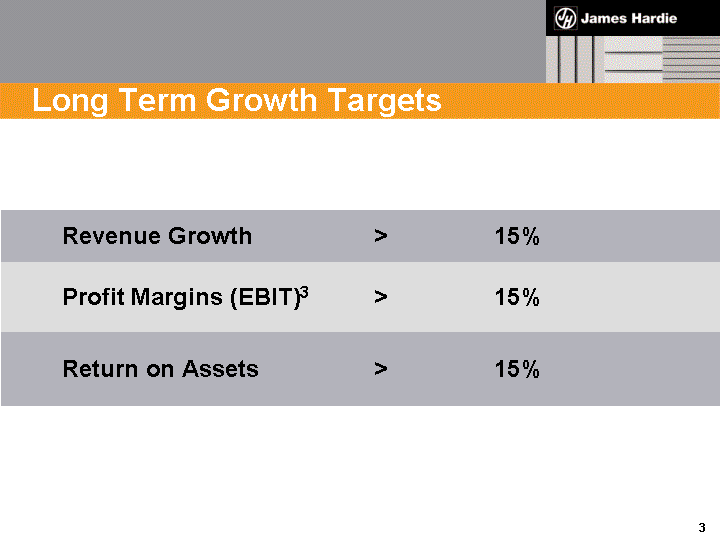
| Long Term Growth Targets Revenue Growth > 15% Profit Margins (EBIT)3 > 15% Return on Assets > 15% |
The company uses a range of targets against which it measures growth and returns.
Three of these targets are that, on average, over the long term
| • | revenue growth will exceed 15% a year | |
| • | profit margins will exceed 15% a year, and | |
| • | return on assets will also exceed 15% a year. |
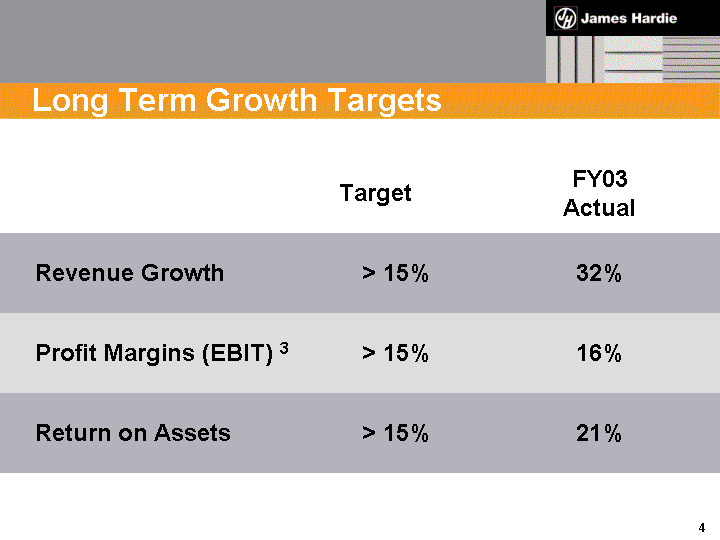
| Long Term Growth Targets Target Target FY03 Actual Revenue Growth > 15% 32% Profit Margins (EBIT) 3 > 15% 16% Return on Assets > 15% 21% |
In the past year, these targets have been exceeded, in some cases quite handsomely, as you can see on this slide.
I cannot promise you that each of these targets will be exceeded by the same generous margin each year, or that each of them will be exceeded in each and every year.
But management is confident that these targets are achievable on average over the long-term.
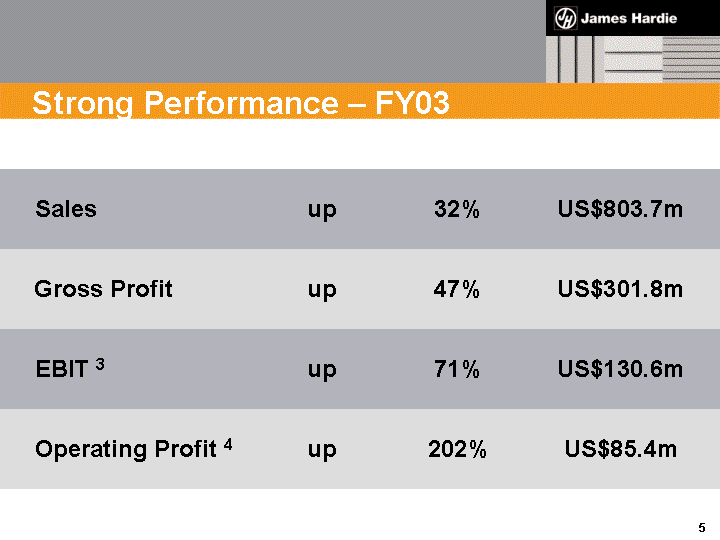
| Strong Performance - FY03 Sales up 32% US$803.7m Gross Profit up 47% US$301.8m EBIT 3 up 71% US$130.6m Operating Profit 4 up 202% US$85.4m |
Other features of our strong performance over the past year are shown on this slide.
Gross Profit was up 47% and Earnings Before Interest and Tax3 was 71% higher. This led to a substantial improvement in the bottom line.
The restructuring costs of more than 10 million US dollars that were incurred in the 2 years before, have been repaid in the first full year since the restructuring was implemented.
In fact, the restructuring is delivering greater benefits than were in our estimates at the time it was approved by shareholders.

| Strong Performance - FY03 Sales up 32% US$803.7m Gross Profit up 47% US$301.8m EBIT 3 up 71% US$130.6m Operating Profit 4 up 202% US$85.4m Net Operating Profit Including Asset Sales 5 up 454% US$170.5m |
The sale of the last of our gypsum assets was completed in March 2003, with the sale of the Las Vegas mine. In total, gypsum asset sales generated an after tax profit of about 85 million US dollars, lifting total accounting profit6 for the year to 170 million US dollars.
These sales allowed us to restructure the balance sheet, including the retirement of debt of 60 million US dollars. This will reduce our interest bill in the years ahead.
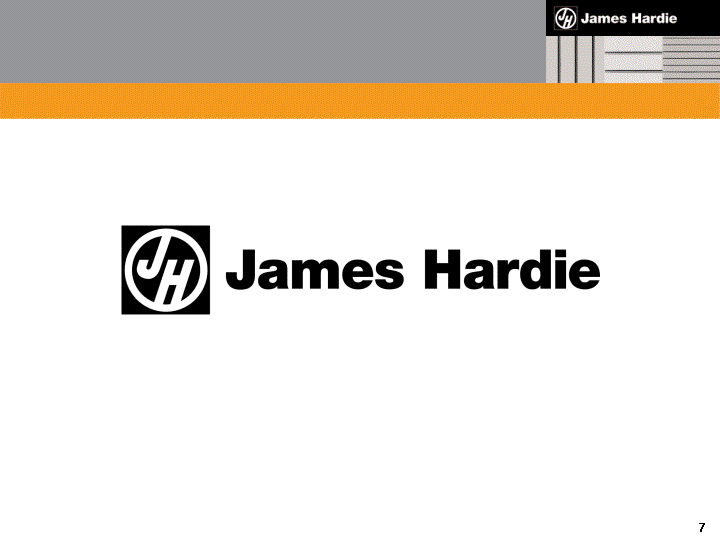
The company’s strong operating performance allowed the Board to declare a final dividend of US 2.5 cents a share, which was paid last month. This payment brought total dividends for the year to US 5.0 cents a share.
The sale of the gypsum assets has also enabled us to recommend a further return of capital to shareholders of US 15 cents per share. If the capital return is approved this week, it will be paid in November, after all legal and administrative processes have been completed.
Perhaps what is not immediately clear is the extent to which there have been cash returns to shareholders in recent years.

| Strong Cash Returns Since December 2001* Dividends US US 10c Capital Returns* US US 40c Total Total US 50c Cash Yield 7% *paid or announced |
Since December 2001, just two months after the restructuring was completed, dividends and capital returns to shareholders either paid or recommended have totalled US 50 cents a share.
This is clearly well above the level of returns that occurred in the earlier years, and our calculations show a combined annual cash yield (dividends and capital returns) of around 7% a year to our shareholders.
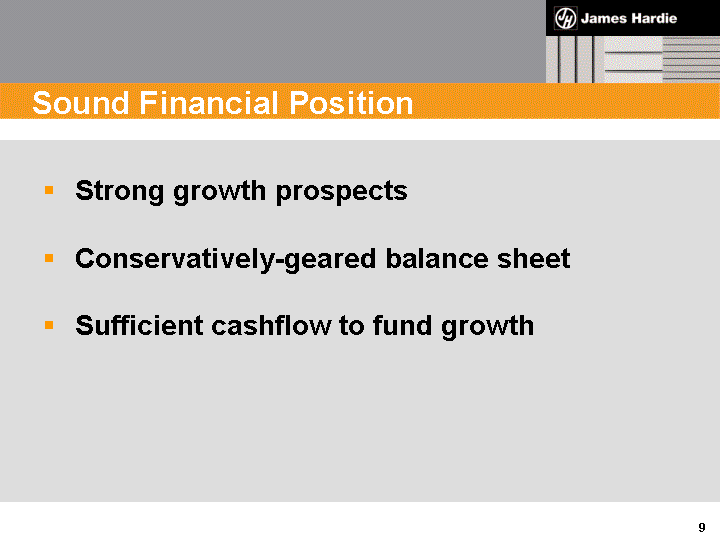
| Sound Financial Position Strong growth prospects Conservatively-geared balance sheet Sufficient cashflow to fund growth |
The company is now in the sound position of having:
| • | strong growth prospects | |
| • | a conservatively geared balance sheet, and | |
| • | sufficient cash flow to pay for its expansion |
without needing to raise new debt or equity to achieve its growth plans.
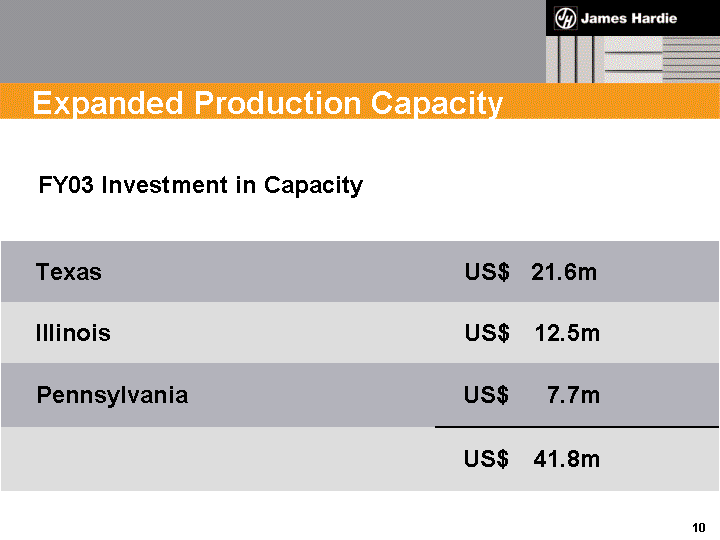
| Expanded Production Capacity FY03 Investment in Capacity Texas US$ US$ 21.6m Illinois US$ US$ 12.5m Pennsylvania Pennsylvania US$ 7.7m US$ 41.8m |
We continue to invest in production capacity so we can meet rapidly growing demand. In the past year, we spent about $42 million US dollars to add capacity in Texas, Illinois and Pennsylvania.
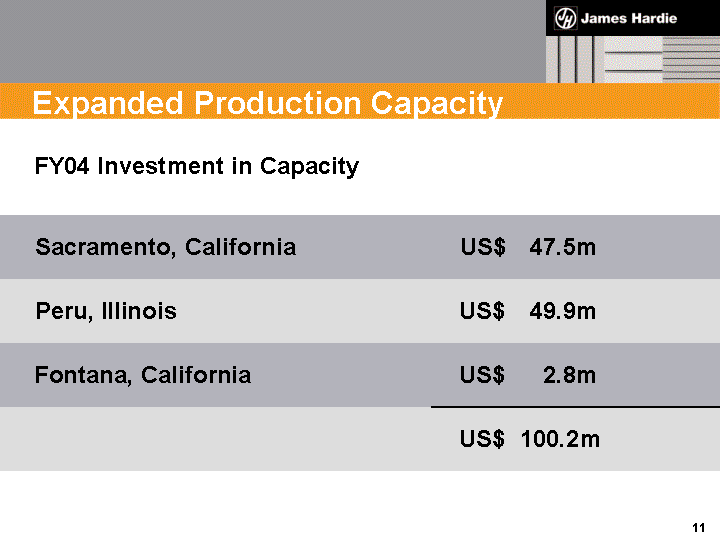
| Expanded Production Capacity FY04 Investment in Capacity Sacramento, California US$ US$ 47.5m Peru, Illinois Peru, Illinois US$ 49.9m Fontana, California Fontana, California US$ 2.8m US$ 100.2m |
The latest of our major growth projects were announced about two weeks ago and involve investment of an additional $100 million US dollars.
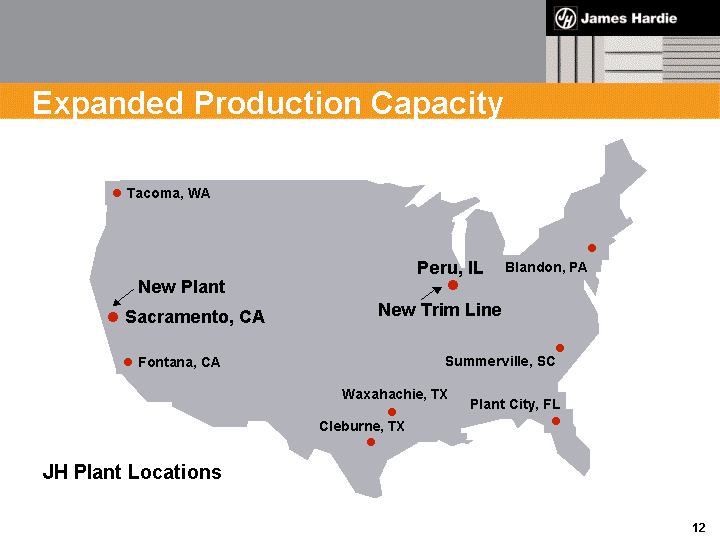
| Expanded Production Capacity Tacoma, WA Fontana, CA Plant City, FL Waxahachie, TX Cleburne, TX Peru, IL Blandon, PA Summerville, SC Sacramento, CA New Trim Line New Plant JH Plant Locations |
These projects include:
US$47.5 million to build a new plant at Sacramento in northern California which will make Hardiplank® siding, panel and backer products. Based on current rates of demand, we will need this production capacity on the west coast next year.
We will also invest US$49.9 million to build a new production line at the plant at Peru in Illinois, which will make our unique low-density Harditrim® products
Additionally, US$2.75 million will be spent to more than double the size of the research and development centre, adjacent to the Fontana plant in southern California.
These projects are scheduled for completion next year and are further, tangible evidence of confidence in the company’s growth potential.
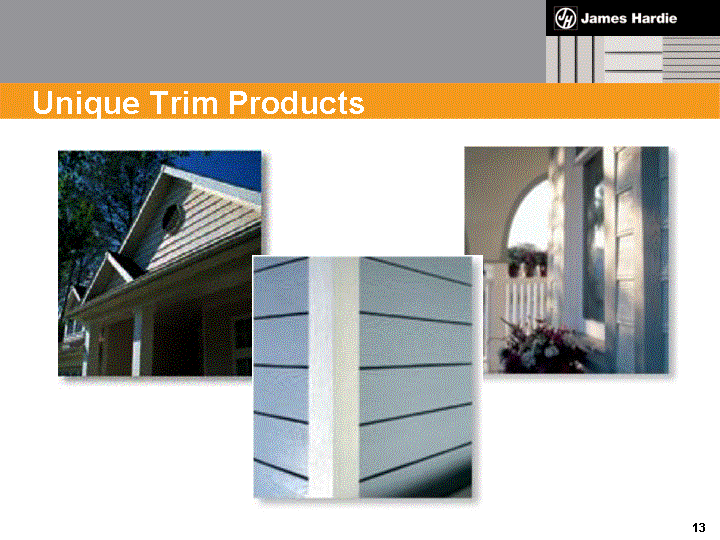
| Unique Trim Products |
Sales of the company’s unique trim products — shown here — have been growing at more than 50% a year. The new production line in Illinois will allow us to pursue sales in the mid-west and northeast of the country where we see strong potential for Harditrim®.
The new trim line will employ the next generation of the unique technology that was developed by the company in 1999. The low-density formulation we use to make trim is protected by patent and the new line will enable us to make trim products in higher volumes and at lower cost.
These projects further extend what we believe is already a significant competitive advantage. Let me give you two examples.

| Increased Scale 1990 1994 1998 2001 2003 mmsf 60 100 150 200 300 Production Capacity Per Line |
The new plant at Sacramento will have 50% more capacity than our next largest line, but cost only fractionally more to build. This has been made possible by further advances in plant design and production technology that have been developed by and are proprietary to the company.
This plant design continues the steady progress towards more innovation in production, leading to lower costs.
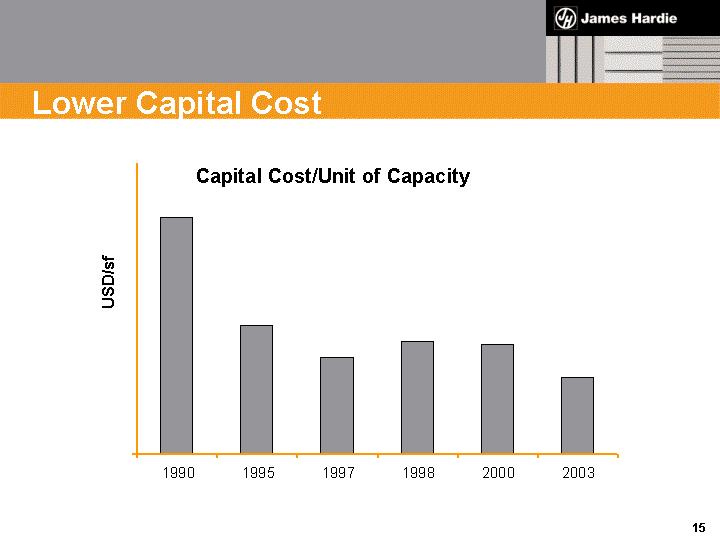
| Lower Capital Cost 1990 1995 1997 1998 2000 2003 USD/sf Capital Cost/Unit of Capacity |
The capital cost of each unit of capacity at this new plant will be one third lower than was the case for the last plant we built. And, as you can see, this continues a strong trend over 10 years in which the unit cost of our capacity has been reduced dramatically.
Furthermore, the operating cost of the new plant will be another 10% lower than our best performing plants today.
On our estimates, competitor’s plants have significantly less capacity than a typical Hardie production line and cost substantially more to build.
With the advances being incorporated into our new facilities, these advantages are being extended further.
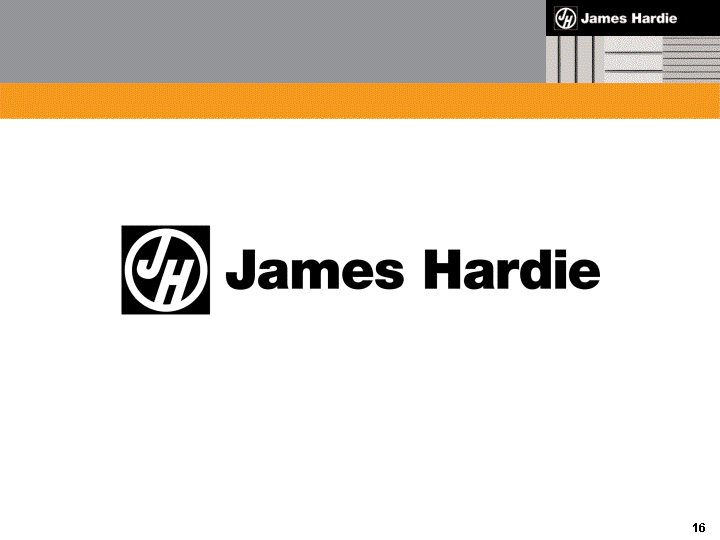
In summary, your company is in a strong financial position, and is pursuing high rates of growth and above-average returns on invested capital.
At the same time, it is working hard to ensure the safety of its workers, train and develop the next generation of managers, and manage the company with honesty and integrity.
Let us now look at the opportunities ahead to capitalise on the advantages conferred by the company’s unique fibre cement technology.

| Competitive Advantages Plants built to James Hardie's own design Engineering and process technology unique to James Hardie Key aspects of technology are patented or have intellectual property protection Unique, differentiated products others can't make |
Our fibre cement manufacturing plants are built to our own designs and incorporate engineering and process technology that is unique to James Hardie. Product formulations are developed in-house and are proprietary. Key aspects of the company’s process and product technology are patented or have other forms of intellectual property protection.
James Hardie makes the widest range of fibre cement products in the industry. Because these unique, differentiated products create more value for customers than competing products, we can achieve higher average selling prices and win market share.
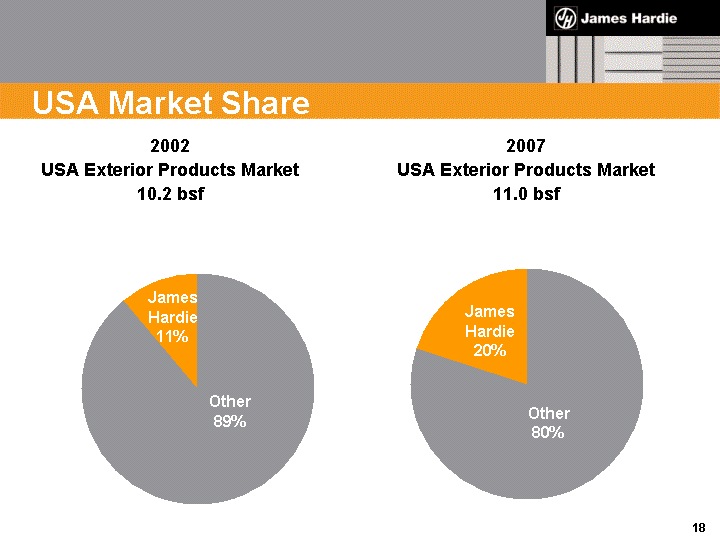
| USA Market Share 2007 USA Exterior Products Market 11.0 bsf James Hardie 20% Other 80% 2002 USA Exterior Products Market 10.2 bsf James Hardie 11% Other 89% |
Our share of the 10 billion square feet USA exterior products market is now above 11%. By 2007, we believe the total market will have grown to about 11 billion square feet and our share could increase strongly to about 20%.
This includes the market for trim, which is 3 billion square feet of the 10 billion I just mentioned. We have a very low share of this market today but this is changing as sales of Harditrim® are growing at more than 50% a year.
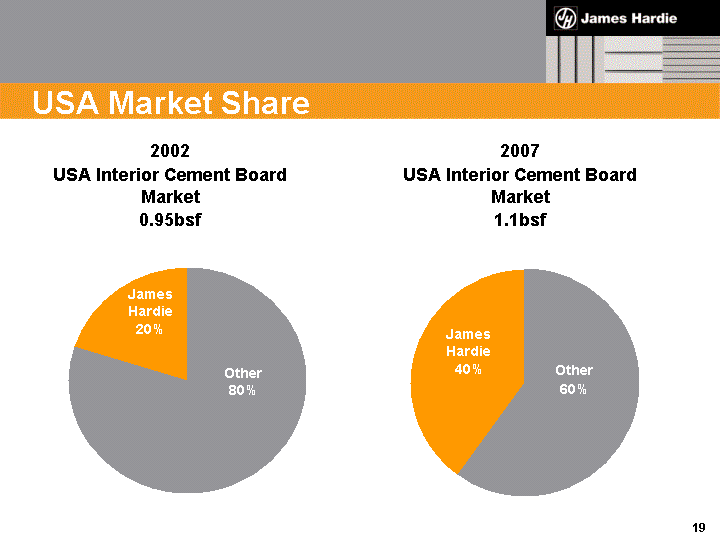
| USA Market Share 2002 USA Interior Cement Board Market 0.95bsf 2007 USA Interior Cement Board Market 1.1bsf James Hardie 40% Other 60% James Hardie 20% Other 80% |
The market for backer boards could grow even faster.
In 2002, we held a 20% share of this market, estimated to be almost 1 billion square feet a year. In the past year, our share has grown to 28%.
By 2007, we believe the total market for these products will have grown by about 10% and our share could exceed 40%.
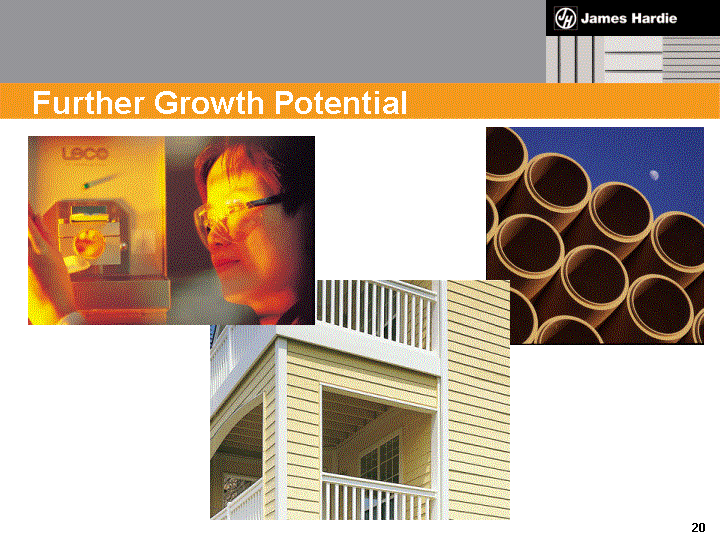
| Further Growth Potential |
We also see significant further growth potential in Australia and New Zealand as we introduce new products that have been proven in the United States.
Our investment in research and development allows us to develop products with improved durability and aesthetics, and for new applications. Some of these new products will reach the market this year; others are still in development.
We see strong potential for Hardie pipes, in both the USA and Australia, because of the considerable cost and performance advantages these pipes have over plastic and conventional steel reinforced concrete pipes.
The USA pipe markets we are targeting generate total sales of US$2 billion a year. Our goal is to improve the performance of our first plant in Florida, where we already have more than a 15% share of the market, then expand into other states. In Australia, we also have a 15% share of our target market and aim to grow this further.
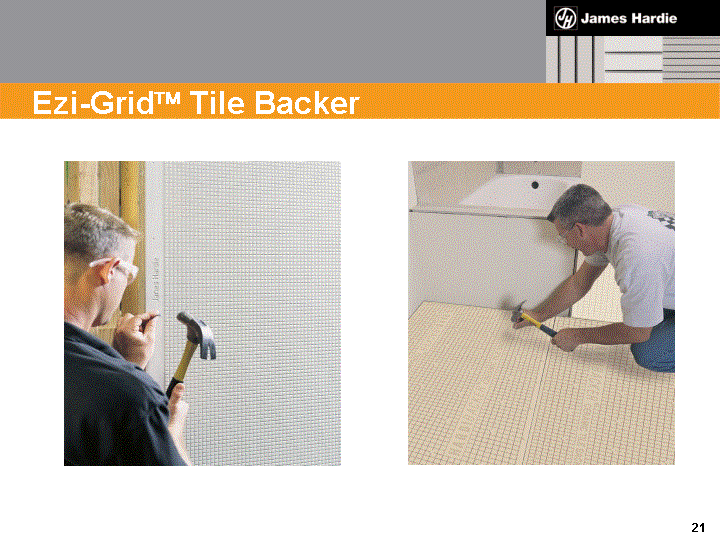
| Ezi-Grid? Tile Backer |
We have recently launched new tile backer boards under the brand name Ezi-Grid™ in the USA and Australia and expect these to increase sales further by making it easier for tilers to complete installations.
A grid embossed into the sheet surface helps tilers estimate straight edges and makes cutting easier and faster. Other features make nailing and joining easier.
This product has patent protection.
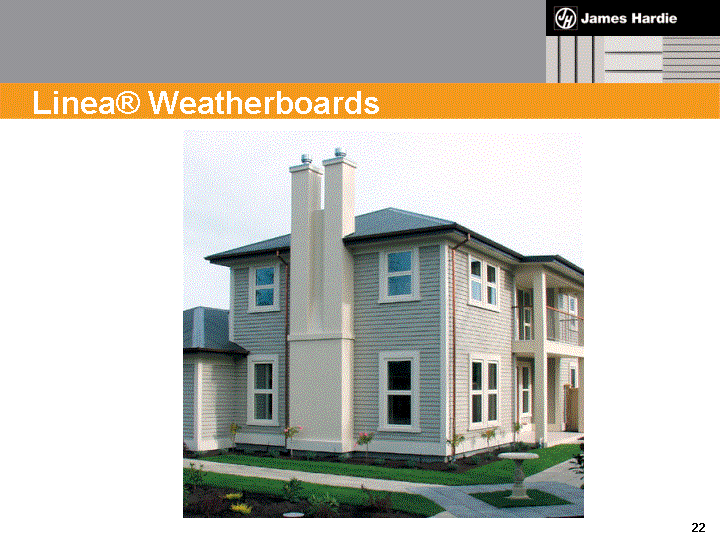
| Linea(r) Weatherboards |
In New Zealand, our new low-density Linea® brand weatherboards have been more successful than even our most optimistic targets and we plan to launch similar products in other markets. Linea® also has patent protection.
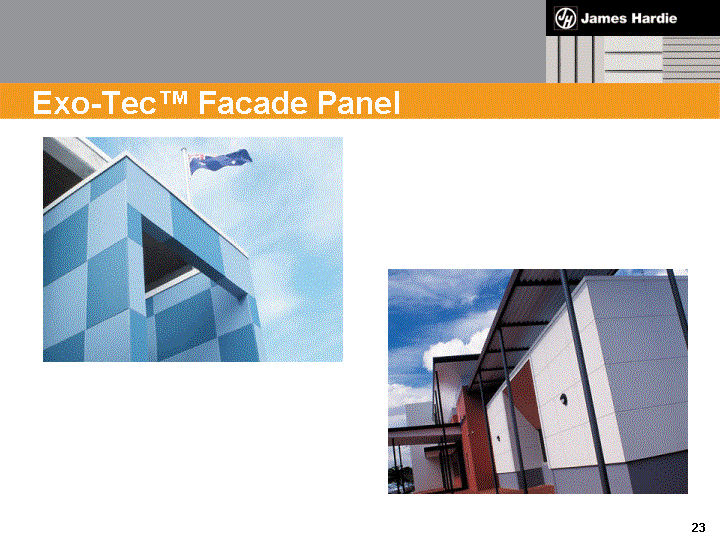
| Exo-Tec(tm) Facade Panel |
Australia is also the site of an exciting development in commercial facade products, with the launch of the more durable ExoTec™ Facade Panel.
Patent protection is pending on several aspects of the technology used in the ExoTec™ Facade Panel.
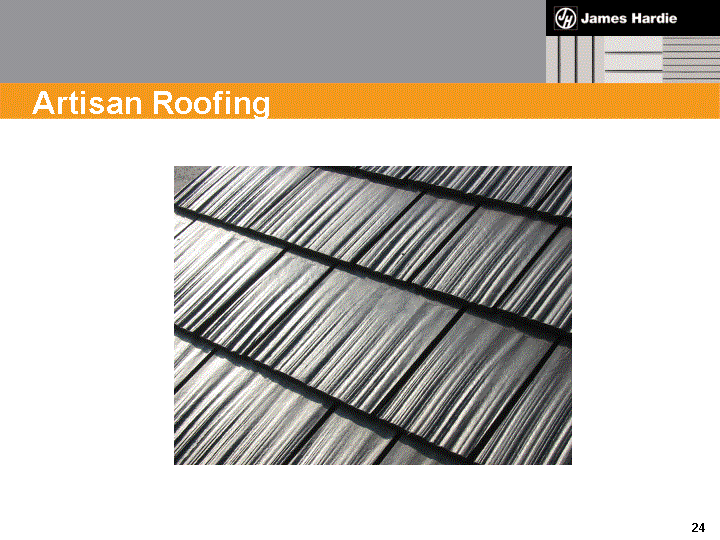
| Artisan Roofing |
We have just completed a new US$12.5 million pilot plant in California to trial a new roofing production technology and a new and extremely durable roofing product, both developed by our in-house R&D team.
A prototype of the new roof product is shown here. If successful, we will be able to enter the large US market for roofing materials. The total market is estimated at more than 13 billion square feet a year. This is much larger than the siding market in which we compete today.
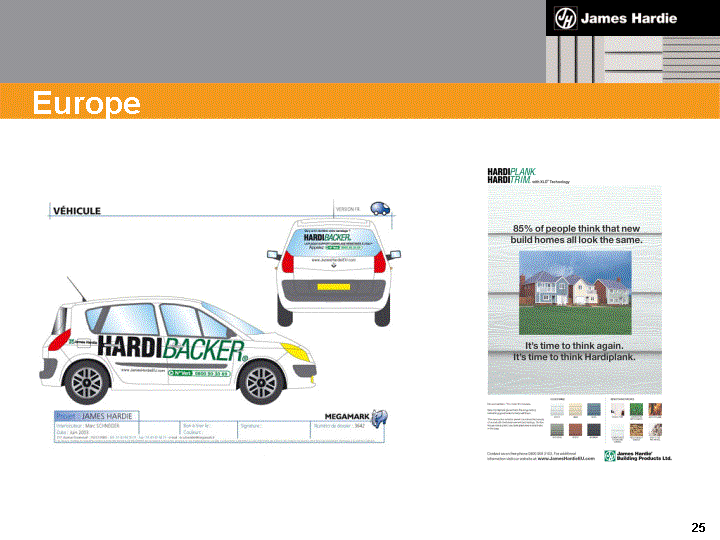
| Europe |
As well as expanding into new product areas, we have also expanded geographically. In February we began selling backer and siding products manufactured in the USA, to the UK and France. These are the first steps in testing the viability of further expansion into Europe, a market that could offer significant potential over the long term.
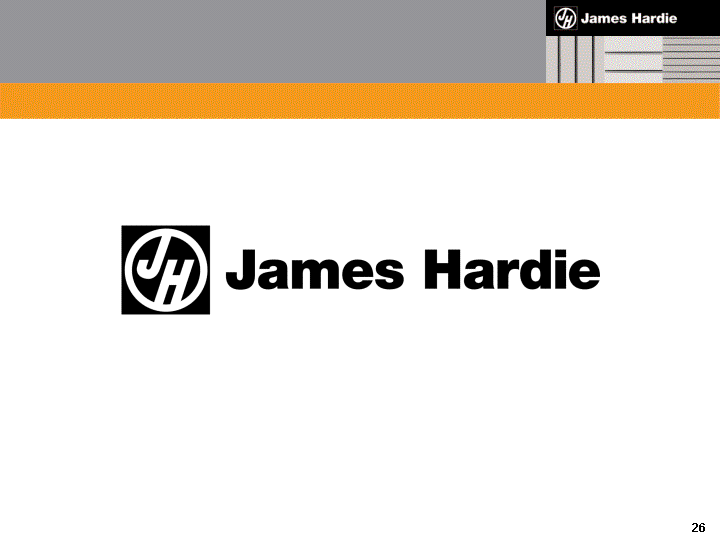
All that I have described depends, of course, on the company’s people. They are one of its greatest assets and we are proud of their achievements. On your behalf, I thank all the company’s management and employees for their efforts.
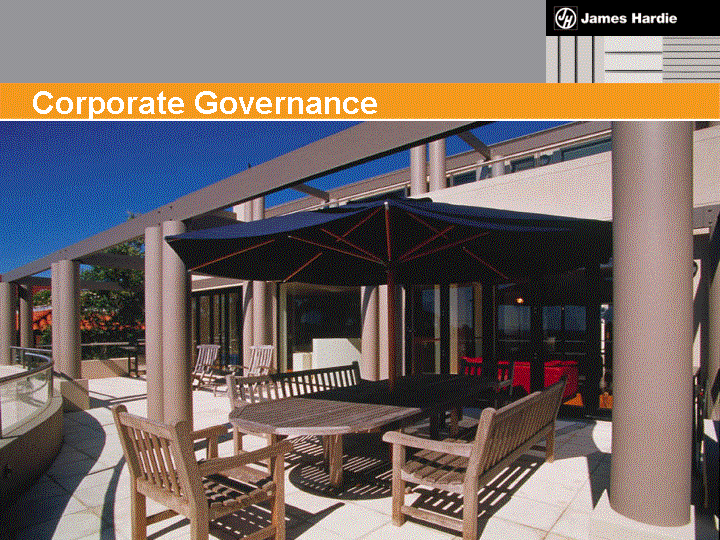
| Corporate Governance |
The subject of corporate governance has been covered extensively in the annual report.
Clearly, this is an area of considerable interest for investors, and there is a demand for companies to publicly address the issues it raises.
I believe this company has sound and well-proven corporate governance practices which have required little amendment to formally comply with all the recent pronouncements and regulations.
The primary focus of good corporate governance should be upon achieving outstanding performance in an ethical manner where high quality outcomes are achieved and can be sustained, and where integrity is clearly evident.
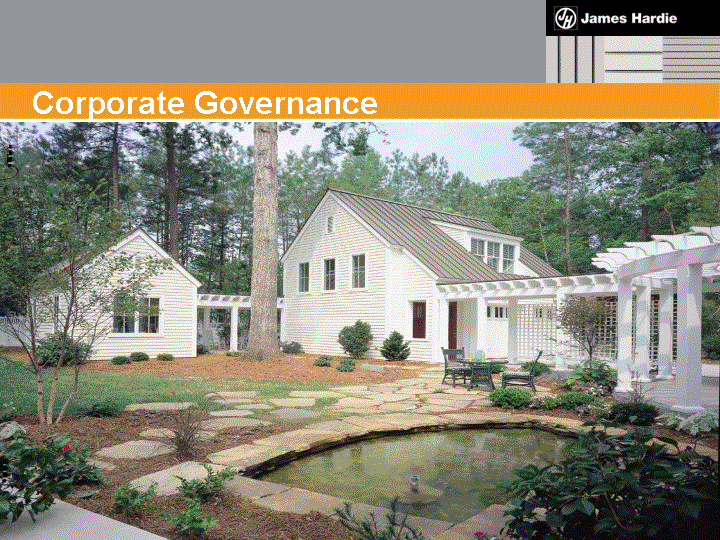
| Corporate Governance |
The Board’s role is to create the conditions that encourage this to occur.
This will be most effectively achieved where the Board is a strong, high-performing team that operates in a climate of openness, trust and candour and where respectful dissent and rigorous debate routinely occur.
Equally, directors should engage directly with senior managers on critical strategies and issues so that they are all involved with, and accountable for, outcomes on behalf of the shareholders.
James Hardie shareholders can be confident that this is how their Board operates.
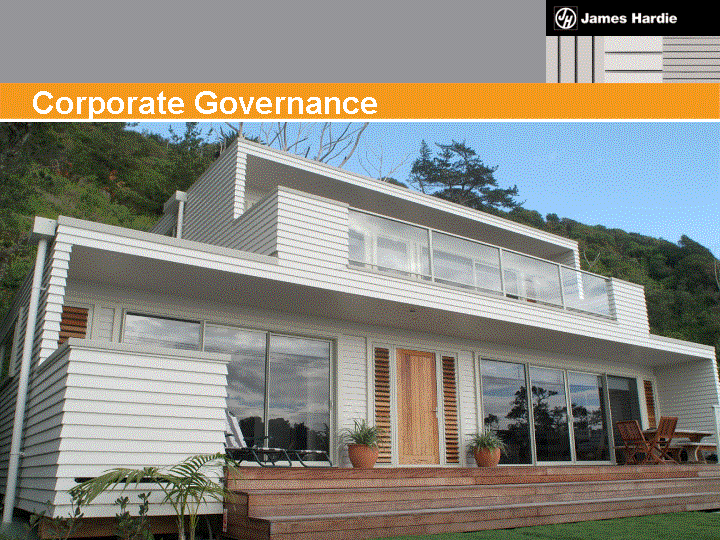
| Corporate Governance |
In the past year, the Board has met in the USA, Australia, New Zealand and Europe — all territories where we have either large business interests or emerging opportunities.
Three Board meetings included extended visits to our operations and meetings with employees and customers to ensure directors are exposed to the business operations and markets, thus assisting them to make decisions about the company’s future.
Your Board has widespread experience that spans general management, finance, law, accounting, marketing, science and technology. Each director also has international experience that is valuable as we expand geographically.
We are also aware of the need to ensure the Board continuously embraces skills and experience that will support the company’s growth aspirations.
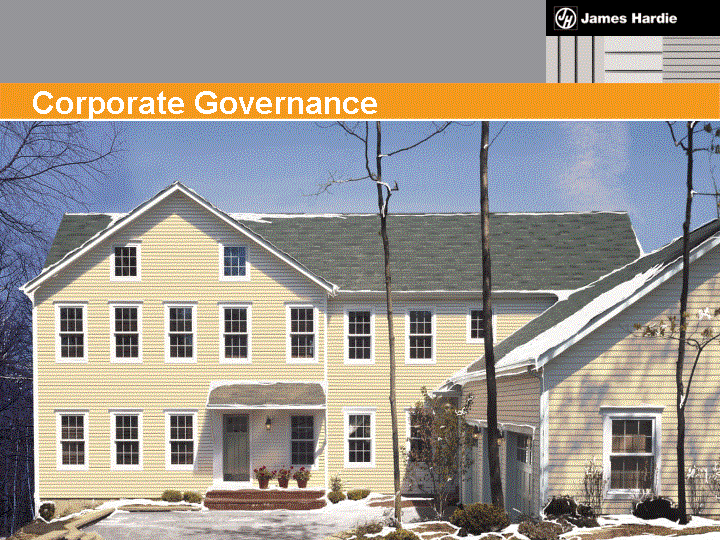
| Corporate Governance |
To that end, I am pleased to be introducing to you today, two new candidates for the Board who, if elected by shareholders, will become independent non-executive directors.
These gentlemen are Mr Peter Cameron and Mr Donald McGauchie. Both have earned strong reputations and have substantial international experience that will serve us well.
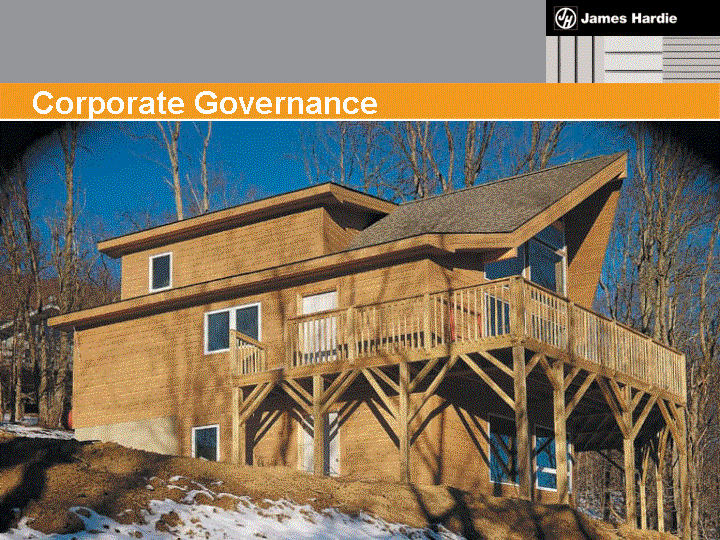
| Corporate Governance |
As you will be aware from your Notice of Meeting, Mr Cameron has a distinguished background in financial services and the law. He is Chairman of Investment Banking in Australia and a Managing Director of Credit Suisse First Boston.
He was formerly a partner and Head of Mergers and Acquisitions with the Australian law firm, Allens Arthur Robinson, providing a wide range of strategic, corporate and securities advice to public companies.
Mr Cameron has been an advisor to some of Australia’s largest corporate takeovers, mergers and corporate reconstructions.
He advised James Hardie for several years, including in connection with the reorganisation in 2001 that resulted in the current group structure. He will bring to the company an unusual and valuable combination — both the independence that he demonstrated as an advisor and a familiarity with, and knowledge of, the company and the risks and challenges that it faces.
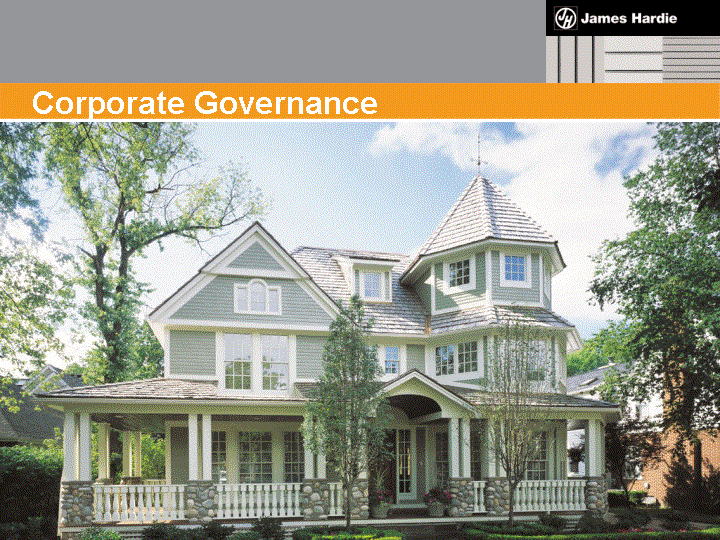
| Corporate Governance |
Mr McGauchie is a Director of The Reserve Bank of Australia, Telstra Corporation Limited and National Foods Limited and Chairman of the Rural Finance Corporation of Victoria and Deputy Chairman of Ridley Corporation and the Australian Wool Testing Authority.
He has had extensive commercial and public policy experience, having previously held several high-level advisory positions to government.
Among many other achievements, Mr McGauchie was earlier this year awarded the Centenary Medal for service to Australian society through agriculture and business.
Both Mr Cameron and Mr McGauchie are residents of Australia. They both satisfy the stringent criteria for independence that is set out in our annual report.
We also plan to appoint an additional USA resident to the Board this year as an independent, non-executive director. I hope to be able to announce that in the near future.
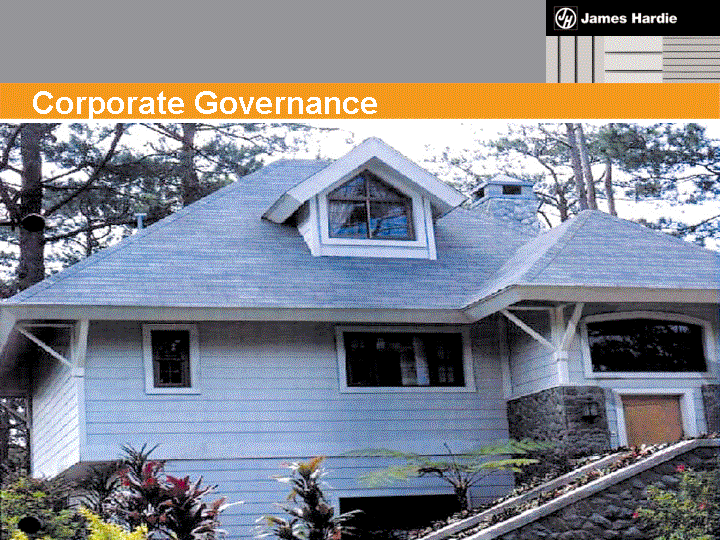
| Corporate Governance |
Our multi-national structure exposes James Hardie to a number of governance and regulatory regimes and requires us to comply simultaneously with rules and community expectations in several different countries.
In this regard, our Australian heritage has served us well and it is apparent to us that Australia has a more robust governance framework than is often recognised.
Shareholders will be reassured to know that our long-standing governance arrangements required only modest changes to documentation to accommodate the recent reforms and best practice recommendations that have been developed in both Australia and the United States.
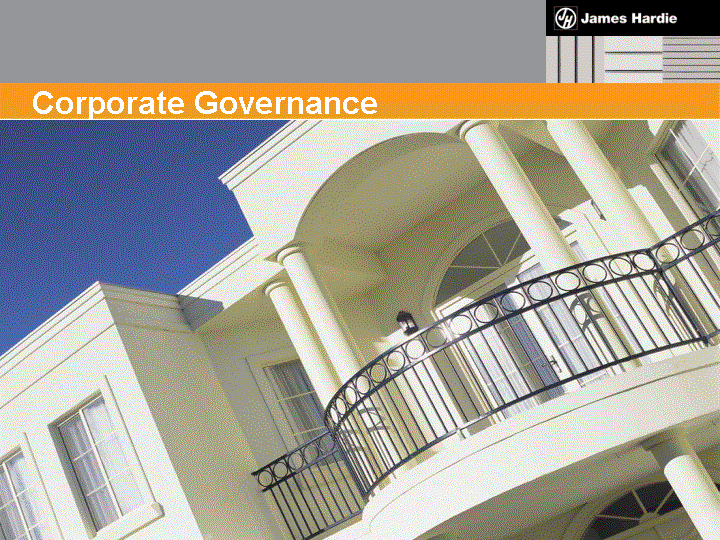
| Corporate Governance |
In March 2003, the Australian Stock Exchange Corporate Governance Council issued new guidelines that become effective this year.
The guidelines provide a framework for good governance and from next year, companies are obliged to explain if and why they do not comply with any of the recommendations.
We took the positive step of reporting against the guidelines a year early. James Hardie already largely complies with almost all of the guidelines and should fully comply within this year. In most cases, this will only involve documenting and disclosing existing practices. Our website is being progressively updated to communicate these developments.
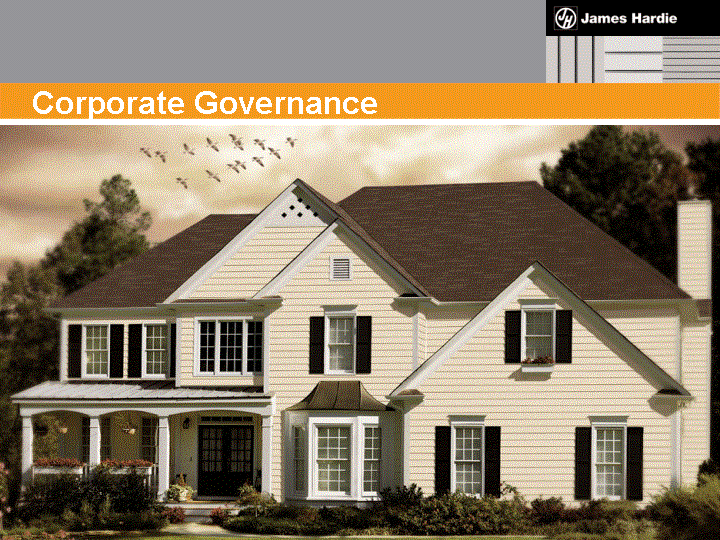
| Corporate Governance |
In 2002 the US Congress introduced new laws and regulations related to governance, disclosure and accountability standards in that country.
In all material respects, James Hardie was already being governed in the manner prescribed in the new laws, including those that are still not mandatory for non-US companies.
We expect to fully comply with the requirements of the Sarbanes-Oxley Act as they become effective, if not sooner.
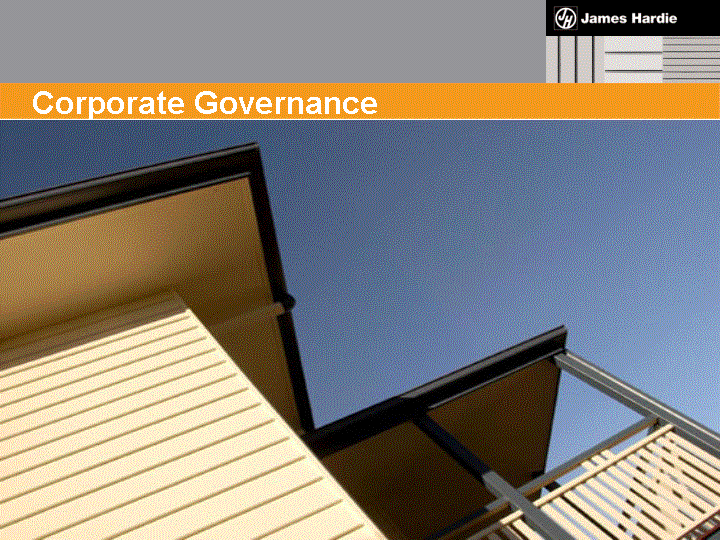
| Corporate Governance |
The company’s practise accords with the new initiatives of regulators and others to ensure that equity markets operate within robust and credible governance frameworks.
We will continue to emphasise transparency, through full and meaningful disclosure; sustained accountability; robust management interaction; the maintenance of high standards of integrity and ethical behaviour; and the implementation of sound policy.
However good governance will not be achieved simply by implementing a regime of prescriptive rules that impose a “one-size-fits-all” requirement to comply.
Good governance should allow companies to be innovative and entrepreneurial so that they can create value for customers, rewarding careers for employees and wealth for shareholders.
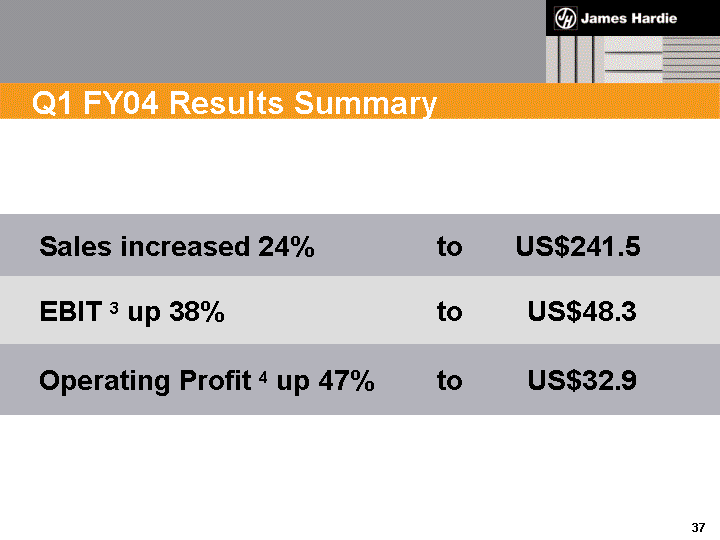
| Q1 FY04 Results Summary Sales increased 24% to US$241.5 EBIT 3 up 38% to US$48.3 Operating Profit 4 up 47% to US$32.9 |
Finally, I will close with some comments about current trading performance.
Yesterday, the company announced its first quarter results for its fiscal year 04 for the three months ended June.
The results are certainly positive and have provided a strong start to the year.
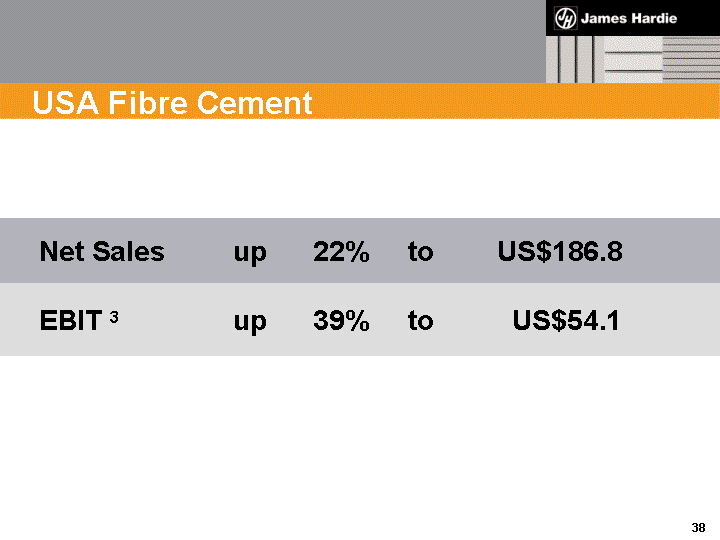
| USA Fibre Cement Net Sales up 22% to US$186.8 EBIT 3 up 39% to US$54.1 |
Our largest business, the USA fibre cement operation, generated a 22% increase in sales due to higher volumes and a higher average selling price. Market share increased in all major product categories and in all parts of the country.
Earnings increased 39% and the EBIT margin3 increased a further 3 percentage points to 29%.
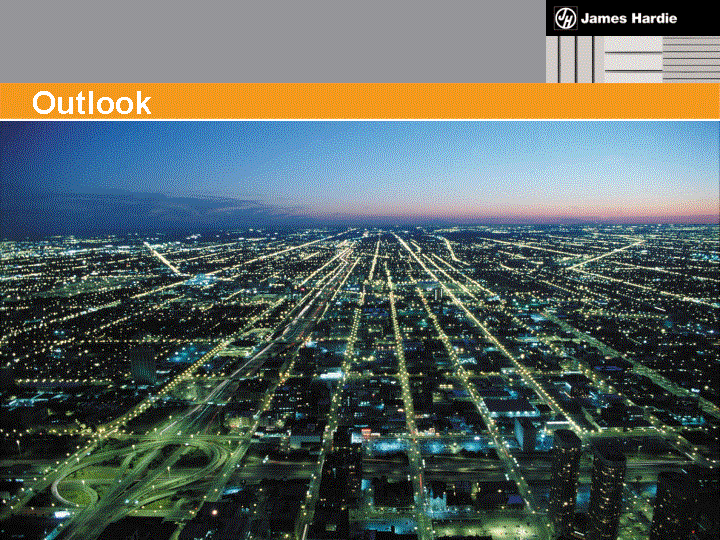
| Outlook |
The outlook for the balance of the year is positive. Demand from our end markets, particularly in the USA, remains at high levels and we are confident of achieving or exceeding the targets I described earlier, for both the USA fibre cement business and the company overall.
As the first quarter results demonstrate, we are on track for increased profits this year. At present, we do not see any reason to believe this trend will not continue.
That concludes my formal address.
I will now turn to the remaining business of the meeting.
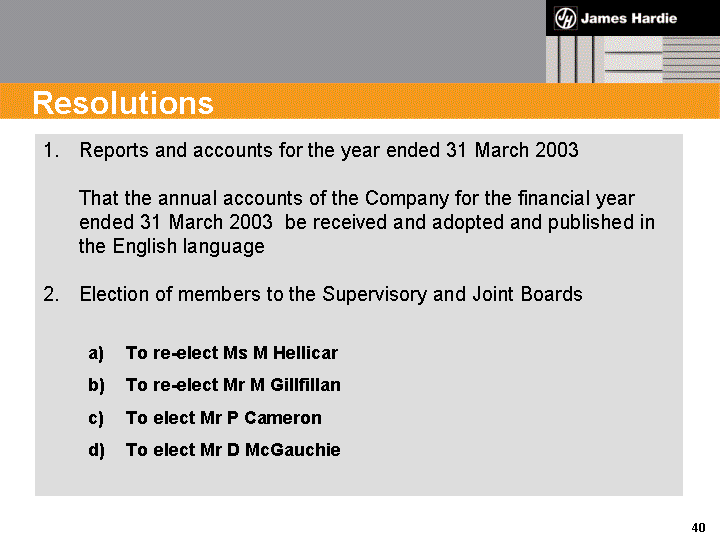
| Resolutions 1. Reports and accounts for the year ended 31 March 2003 That the annual accounts of the Company for the financial year ended 31 March 2003 be received and adopted and published in the English language Election of members to the Supervisory and Joint Boards To re-elect Ms M Hellicar To re-elect Mr M Gillfillan To elect Mr P Cameron To elect Mr D McGauchie |
| 1. | Reports and accounts for the year ended 31 March 2003 | |
| That the annual accounts of the Company for the financial year ended 31 March 2003 be received and adopted and published in the English language | ||
| 2. | Election of members to the Supervisory and Joint Boards |
| a) | To re-elect Ms M Hellicar | ||
| b) | To re-elect Mr M Gillfillan | ||
| c) | To elect Mr P Cameron | ||
| d) | To elect Mr D McGauchie |
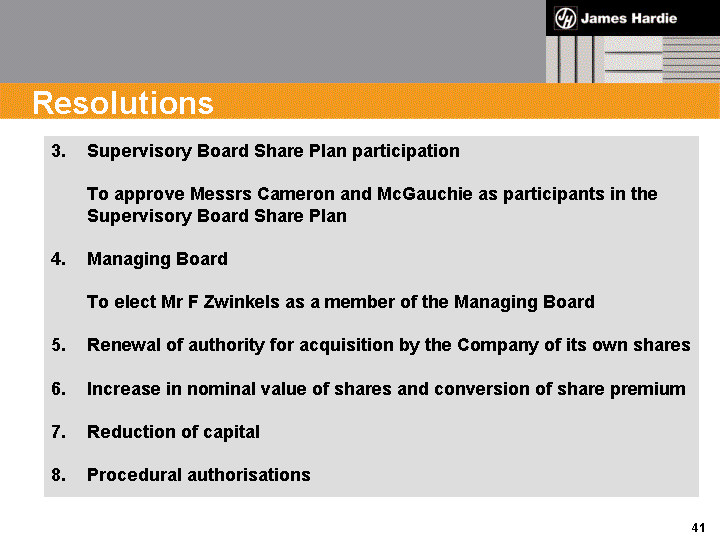
| Resolutions Supervisory Board Share Plan participation To approve Messrs Cameron and McGauchie as participants in the Supervisory Board Share Plan Managing Board To elect Mr F Zwinkels as a member of the Managing Board Renewal of authority for acquisition by the Company of its own shares Increase in nominal value of shares and conversion of share premium Reduction of capital Procedural authorisations |
| 3. | Supervisory Board Share Plan
participation To approve Messrs Cameron and McGauchie as participants in the Supervisory Board Share Plan |
|
| 4. | Managing Board To elect Mr F Zwinkels as a member of the Managing Board |
|
| 5. | Renewal of authority for acquisition by the Company of its own shares | |
| 6. | Increase in nominal value of shares and conversion of share premium | |
| 7. | Reduction of capital | |
| 8. | Procedural authorisations |

| Disclaimer This presentation contains forward-looking statements. Words such as "believe,'' "anticipate,'' "plan,'' "expect,'' "intend,'' "target,'' "estimate,'' "project,'' "predict,'' "forecast,'' "guideline,'' "should,'' "aim'' and similar expressions are intended to identify forward-looking statements but are not the exclusive means of identifying such statements. Forward-looking statements involve inherent risks and uncertainties. We caution you that a number of important factors could cause actual results to differ materially from the plans, objectives, expectations, estimates and intentions expressed in such forward-looking statements. These factors, which are further discussed in our reports submitted to the Securities and Exchange Commission on Forms 20-F and 6-K and in our other filings, include but are not limited to: competition and product pricing in the markets in which we operate; general economic and market conditions; compliance with, and possible changes in, environmental and health and safety laws; dependence on cyclical construction markets; the supply and cost of raw materials; our reliance on a small number of product distributors; the consequences of product failures or defects; exposure to environmental or other legal proceedings; and risks of conducting business internationally. We caution you that the foregoing list of factors is not exclusive and that other risks and uncertainties may cause actual results to differ materially from those contained in forward-looking statements. Forward-looking statements speak only as of the date they are made. |
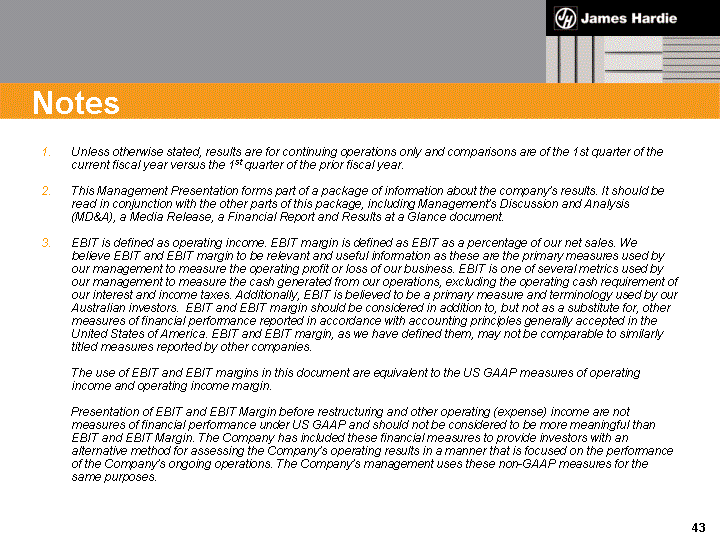
| Notes Unless otherwise stated, results are for continuing operations only and comparisons are of the 1st quarter of the current fiscal year versus the 1st quarter of the prior fiscal year. This Management Presentation forms part of a package of information about the company's results. It should be read in conjunction with the other parts of this package, including Management's Discussion and Analysis (MD&A), a Media Release, a Financial Report and Results at a Glance document. EBIT is defined as operating income. EBIT margin is defined as EBIT as a percentage of our net sales. We believe EBIT and EBIT margin to be relevant and useful information as these are the primary measures used by our management to measure the operating profit or loss of our business. EBIT is one of several metrics used by our management to measure the cash generated from our operations, excluding the operating cash requirement of our interest and income taxes. Additionally, EBIT is believed to be a primary measure and terminology used by our Australian investors. EBIT and EBIT margin should be considered in addition to, but not as a substitute for, other measures of financial performance reported in accordance with accounting principles generally accepted in the United States of America. EBIT and EBIT margin, as we have defined them, may not be comparable to similarly titled measures reported by other companies. The use of EBIT and EBIT margins in this document are equivalent to the US GAAP measures of operating income and operating income margin. Presentation of EBIT and EBIT Margin before restructuring and other operating (expense) income are not measures of financial performance under US GAAP and should not be considered to be more meaningful than EBIT and EBIT Margin. The Company has included these financial measures to provide investors with an alternative method for assessing the Company's operating results in a manner that is focused on the performance of the Company's ongoing operations. The Company's management uses these non-GAAP measures for the same purposes. |

| Notes Cont... 4. Operating profit from continuing operations before income taxes is equivalent to the US GAAP measure of income from continuing operations before income taxes. Net operating profit including asset sales is equivalent to the US GAAP measure of net income. Total accounting profit is equivalent to the US GAAP measure of net income. |
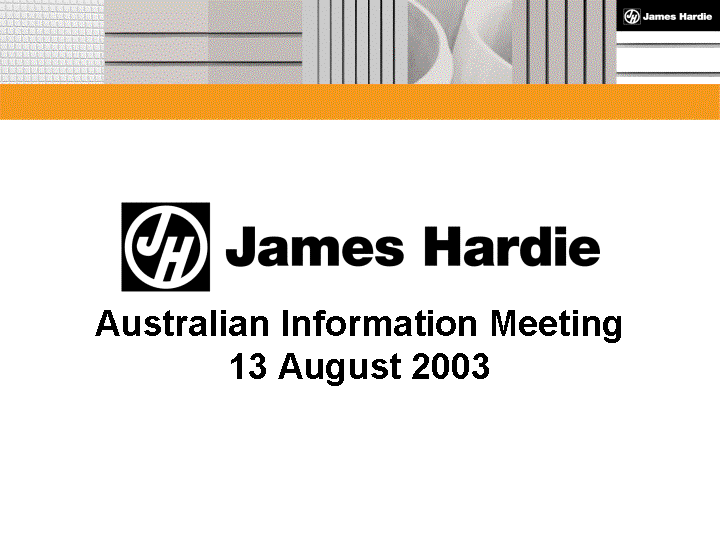
| Australian Information Meeting 13 August 2003 |